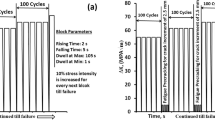Abstract
The aim of this study is to investigate the effects of an intermittent rest period at 300°C, overload in tension, and the combination of an overload and a subsequent rest period on fatigue crack growth in AISI 4340 steel. The intermittent rest period was found to stop fatigue crack growth completely near threshold level of ΔK. The alleviation effect of a rest period on crack growth was more distinct at the lower level of ΔK. In overload, the greater overload ratio (OLR=3) caused more alleviated effect on crack growth rate. The reduced stress intensity factor by crack branching and enhanced roughness of crack surface are proposed to contribute to the retardation and arrest of fatigue crack growth. The most distinct retardation of fatigue crack growth was found after the combined treatment of a overload and a subsequent rest period.
Similar content being viewed by others
Abbreviations
- a :
-
Crack length in CT specimen
- a :
-
Ratio of crack length to specimen width (a/w)
- B :
-
Thickness of CT specimen
- COD(Δδ):
-
Crack opening displacement
- Dp :
-
Plastic ductility (Dp=In 100/(100−RA(%)))
- ef :
-
Elongation ductility
- H RC :
-
Rockwell hardness
- ΔK :
-
Stress intensity factor range
- ΔK eff :
-
Effective stress intensity range defined asK max −K op orK max −K cl
- K max :
-
Maximum stress intensity factor
- Kop(Kcl) :
-
Crack opening (or close) stress intensity factor
- ΔK th :
-
Threshold stress intensity factor range
- OLR :
-
Overload ratio (max. stress intensity factor during overload/max. stress intensity factor during constant load fatigue test)
- ΔP :
-
Load range
- P op :
-
Opening load
- R :
-
Load ratio defined as minimum load to maximum load
- RA :
-
Reduction in area
- σu :
-
Ultimate tensile strength
- W :
-
Width of CT specimen
- σ y :
-
Yield strength
- σ yc :
-
Cyclic yield stress
References
ASTM Standard E647, 1987, “Standard Test Method for Constant Load Amplitude Fatigue Crack Growth Rates,” 1987 Annual Book of ASTM Standard Vol. 03, 01, pp. 711–731.
Benard, P.J., Lindley, T.T. and Richards, C.E., 1976, “Mechanisms of Overload Retardation During Fatigue Crack Propagation,” ASTM STP 595, pp. 78–97.
Bilby, B.A., Cardew, G.E. and Howards, I.C., 1977, “Stress intensity Factors at the tip of Kinked and Forked Cracks,” in Fracture (Edited by Taplin. D.M.R.), 3, pp.197–200.
Elber, W., 1971, “The Significance of Fatigue Crack closure,” ASTM STP 486, pp. 230–242.
Garrett, G.G. and Knott, J.F., 1976, “On the Influence of Cyclic Hardening and Crack Opening Displacement (COD) on Crack Advance During Fatigue,” Met. Trans AIME, 7A, pp. 884–887.
Harries, D.R. and Smith, G.C., 1959, “Fatigue Damage and Crack Formation in Pure Aluminum,” J. Institute of Metals 88, pp. 182–185.
Kim, S.H., 1983, “The Effect of Intermittent Rest Periods at Elevated Temperatures on the Fatigue Properties of 4140 steel,” Proc. of the 4th International Conference on Mechanical Behaviour of Materials 2, Pergamon Press, pp.825–831.
Kim, S.H., 1986, “The Effect of Rest Period at 300°C on Fatigue Crack Growth of 4140 Steel. The 10th Australasian Conference on the Mech. of Structure and Materials 2. Univ. of Adelaide, pp.483–488.
Dudva, S.M. and Duquette, D.J., 1982, “Effect of Surface Residual Stress on the Fretting Fatigue of 4340 Steel,” ASTM STP 776, pp. 195–203.
Liu, H.W., and Liu, D., 1982, “Near Threshold Fatigue Crack Growth Behaviour,” Scr. Metall. 16, pp. 595–600.
Miller, K.J. and Hatter, D.J., 1972, “Increases in Fatigue Life Caused by the Introduction of Rest Periods,” J. Strain Analysis 7, pp. 69–73.
Miller, K.J. and Plumbridge, W.J., 1976, “Influence of a Zero-load Rest Period in Elevated Temperature Fatigue,” J. Strain Analysis 11, pp. 235–239.
Rice, J.R., 1967, “Theory and Practice of Fracture Mechanics,” Edited by R.I.Stephens, Dept. of Materials Eng., Monash Univ. Lecture, No.5.
Suresh, S., 1983, “Crack Deflection: Implication for the Growth of Long and Short Fatigue Cracks,” Metall. Trans. A, 14A, pp. 2375–2384.
Suresh, S., 1983, “Micromechanisms of Fatigue Crack Growth Retardation following overloads,” Engng Fracture Mech., 18, pp. 577–593.
Suresh, S., 1985, “Fatigue Crack Deflection and Fracture Surface Contact; Micromechanical Models,” Metall. Trans. A 16A, pp. 249–260.
Ward-Close, C.M., Blom, A.F. and Ritchie, R.O., 1989, “Mechanisms Associated with Transient Fatigue Crack Growth under Variable-amplitude Loading: An Experimental and Numerical Study,” Engng Mech., 32, pp. 613–638.
Author information
Authors and Affiliations
Rights and permissions
About this article
Cite this article
Kim, SH., Tai, WP. Fatigue crack propagation behaviour of a Ni−Cr−Mo steel due to rest period and overload. KSME Journal 5, 79–85 (1991). https://doi.org/10.1007/BF02953605
Received:
Issue Date:
DOI: https://doi.org/10.1007/BF02953605




